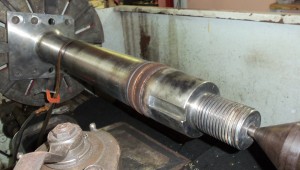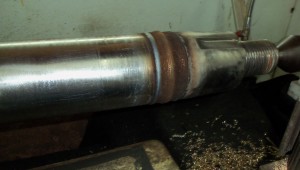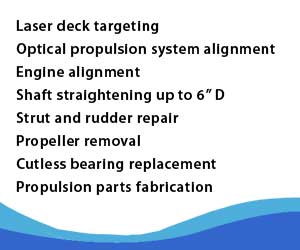Rudder Stock Cladding
While many captains and engineers are familiar with propulsion shaft cladding Propulsion Shaft Cladding, few know that cladding techniques are also applicable on rudder stock. The stock, less the flag is lathe turned to provide the optimal surface for cladding. After the removal of defective metal, the stock is built-up (cladded) to exceed the diameter of the stock on either side of the cladded area. Afterwards, the stock is returned to the lathe to remove the precise amount of cladding to make the stock uniform in diameter and without a detectable seam at the repair. The finished product is a stock which is as good as new.
Detection of Rudder Stock Problems
With a wet vessel, the sight of moisture around the stock is an indication of a problem with the stock, bearings, seals, bushings, or all. For a dry vessel, the accumulation of salt around the stock is the telltale sign of seawater intrusion. From the exterior of a hauled vessel, the “rudder bump test” is a simple, but effective diagnostic. The amount and type of “play” indicates that some or multiple items are worn and needing service. Side-to-side play is a sign of lower bearing wear. Twisting play means that pins, bushing, and joints in the tiller arm require service.
Replace or Clad
Frequently, the question posed is whether to replace or clad. The answer is simple…time, money, and quality. The typical time to clad or replace is days versus weeks. The cost for cladding is about 80% less, and the finished product is every bit as serviceable as a new replacement. With reduced costs, high quality, and much faster turnarounds…cladding is the preferred choice.
Straight Line Marine is the only machine shop in Florida that is approved by ABS for Cladding on ABS class vessels. ABS Announcement Article




 Click to watch the video of a day at High Seas Yacht Service.
Click to watch the video of a day at High Seas Yacht Service. Click to watch Marine Industries Association of South Florida video featuring Salty Jobs at High Seas Services.
Click to watch Marine Industries Association of South Florida video featuring Salty Jobs at High Seas Services.
Comments are closed.